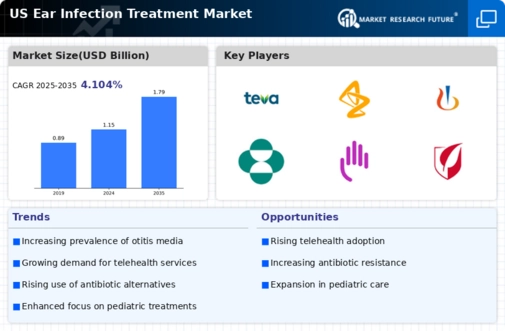Growing Pediatric Population
The increasing pediatric population in the US is a notable driver for the ear infection-treatment market. As children are particularly susceptible to ear infections, the rise in birth rates and the overall growth of the youth demographic contribute to a higher incidence of these conditions. According to recent data, approximately 5 million children in the US experience ear infections annually, leading to a substantial demand for effective treatment options. This trend is likely to continue, as the population of children under 18 is projected to reach 74 million by 2030. Consequently, healthcare providers are focusing on developing targeted therapies and preventive measures, which may further stimulate growth in the ear infection-treatment market. The emphasis on pediatric care is expected to drive innovation and investment in this sector.
Technological Advancements in Diagnostics
Technological advancements in diagnostic tools are significantly impacting the ear infection-treatment market. Innovations such as digital otoscopy and telemedicine platforms enable healthcare professionals to diagnose ear infections more accurately and efficiently. These technologies facilitate remote consultations, allowing for quicker treatment decisions and improved patient outcomes. The market for diagnostic devices is projected to grow at a CAGR of 6.5% through 2027, reflecting the increasing reliance on advanced diagnostic methods. Moreover, the integration of artificial intelligence in diagnostic processes may enhance the accuracy of identifying ear infections, leading to timely interventions. As these technologies become more accessible, they are likely to drive the demand for treatment options, thereby influencing the overall growth of the ear infection-treatment market.
Growing Awareness of Preventive Healthcare
Growing awareness of preventive healthcare is influencing the ear infection-treatment market positively. Patients and caregivers are increasingly recognizing the importance of early intervention and preventive measures to reduce the incidence of ear infections. Educational campaigns and resources provided by healthcare organizations are fostering a proactive approach to ear health. This shift in mindset is likely to lead to increased consultations and screenings, ultimately driving demand for treatment options. Additionally, the emphasis on preventive care aligns with broader healthcare trends focused on reducing overall healthcare costs and improving patient outcomes. As awareness continues to rise, the ear infection-treatment market may see a corresponding increase in the adoption of preventive strategies and therapies.
Increased Investment in Healthcare Infrastructure
Increased investment in healthcare infrastructure in the US is a crucial driver for the ear infection-treatment market. The expansion of healthcare facilities and the enhancement of service delivery systems are improving access to care for patients suffering from ear infections. Government initiatives aimed at bolstering healthcare access, particularly in underserved areas, are likely to result in higher diagnosis and treatment rates. Furthermore, the allocation of funds towards research and development in otolaryngology is expected to yield innovative treatment options. As healthcare systems evolve, the ear infection-treatment market may experience growth due to improved patient access and the introduction of advanced therapies. This investment trend is anticipated to create a more robust framework for addressing ear infections effectively.
Rising Incidence of Allergies and Respiratory Conditions
The rising incidence of allergies and respiratory conditions in the US is contributing to the growth of the ear infection-treatment market. Allergies can lead to inflammation and fluid buildup in the Eustachian tubes, increasing the likelihood of ear infections. Recent studies indicate that approximately 30% of children with allergies experience recurrent ear infections, highlighting the connection between these health issues. As the prevalence of allergic rhinitis and asthma continues to rise, healthcare providers are likely to see a corresponding increase in ear infection cases. This trend may prompt a greater focus on integrated treatment approaches that address both allergies and ear infections, thereby expanding the market for effective therapies. The ear infection treatment market is expected to benefit from this growing awareness and the need for comprehensive care solutions.
























Leave a Comment